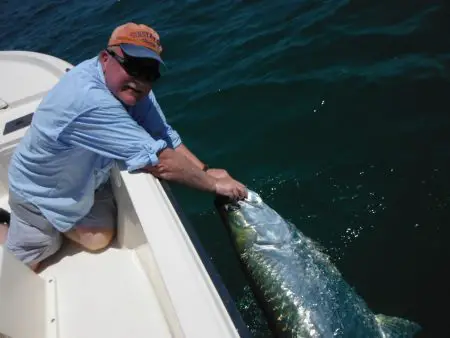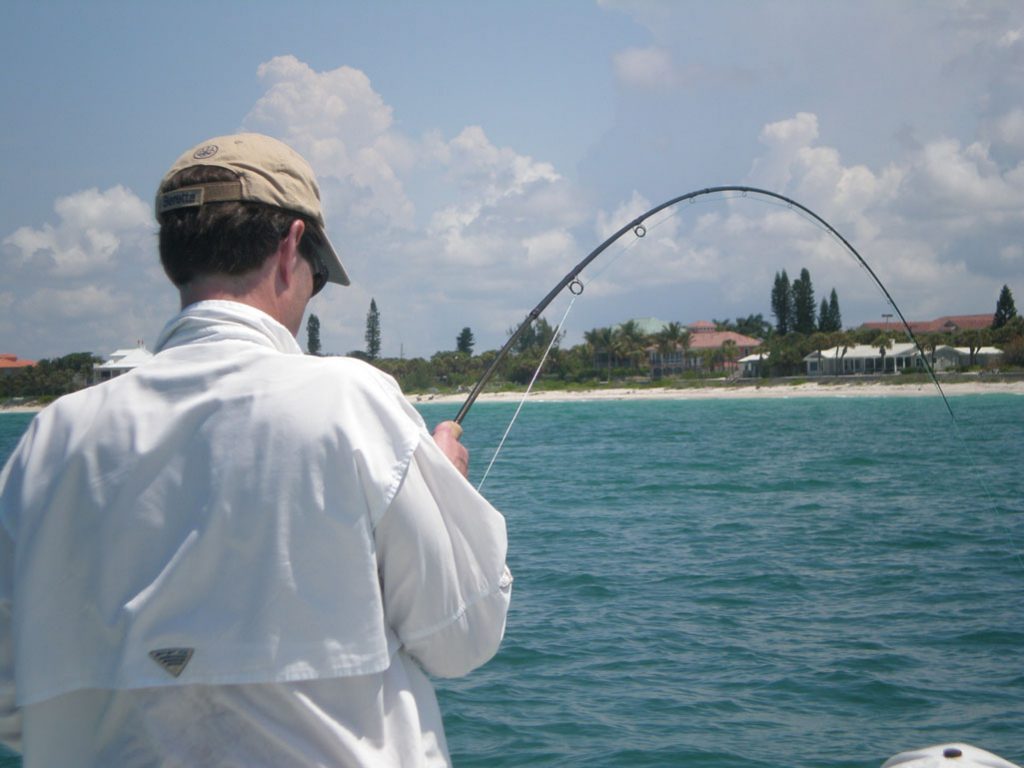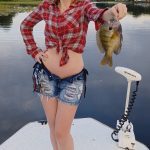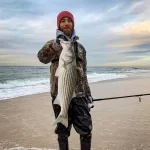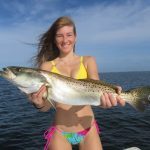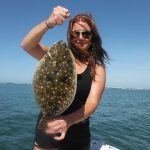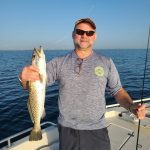Tarpon Fishing – Tips, Tackle, and Techniques
This article will thoroughly cover tarpon fishing, focused on Florida. Tarpon are the premier inshore saltwater species on the planet. Florida offers anglers the best chance to catch a trophy tarpon in the United States.
Anglers tarpon fishing in Florida relish the opportunity to catch a trophy fish of a lifetime. Many anglers consider Atlantic tarpon, Megalops atlanticus, to be the ultimate angling challenge! Florida tarpon average 75 pounds and grow to over 200 pounds. Tarpon are available to anglers along the entire Florida coastline.
Tarpon can not tolerate cold water. They spend their winters in the mild waters of the Florida Keys and the Caribbean. As it warms up, fish will migrate north along both coasts of Florida. On the east cost, tarpon can be found as far north as North Carolina. On the west coast, fish will be found along the entire Gulf Coast.
Best tackle for tarpon fishing in Florida
Many anglers opt for spinning tackle when tarpon fishing in Florida. There are several reasons for this. Surprisingly, tarpon often feed on smaller baits such as live shrimp and crabs. These do not weigh very much and spinning tackle allows anglers to get the bait out a reasonable distance. The same principle applies to anglers casting lighter artificial lures towards rolling tarpon as well.
Check out this article on inshore saltwater fishing in Florida
7 foot to 8 foot heavy spinning rods with a fast action are the best choice when fishing for tarpon in Florida. The soft tip allows for those lighter baits to be cast out, while the stout butt section gives anglers the power they need to fight a huge fish. The rod is paired with a matching reel, usually and the 6000 to 8000 size. Most anglers opt for braided line in the 50 pound range as it allows for longer casts and more capacity on the spool.
Anglers can click these links to shop for a Shimano Baitrunner fishing reel and custom tarpon fishing rod
Conventional tackle for tarpon fishing
Conventional tackle can also be used as well. Anglers use conventional tackle when tarpon fishing in Florida in a couple of different circumstances. Vertical presentations are used in passes and inlets; no casting is required as the bait or lure is lowered straight to the bottom. Conventional rods are also a good choice when fishing live or large cut baits from either an anchored or drifting boat.
Many saltwater anglers already own a conventional outfit that will be fine for targeting Florida tarpon. As was spinning rods, longer rods in the 7 foot to 8 foot range with a fast action work best. Reels are generally spooled up with 50 pound braided line.
Anglers can click this link to shop Amazon for a Penn conventional rod and reel
“Fishing Lido Key is a participant in the Amazon Associates Program, an affiliate advertising program designed to provide a means for sites to earn advertising fees by advertising and linking to Amazon. As an Amazon Associate I earn from qualifying purchases.”
Fly fishing for tarpon is extremely popular as well, particularly in the Florida Keys. The shallow, clear water and abundance of tarpon make it a prime spot to target these trophy fish. However, they are difficult to hook and land! 12Wt outfits with a floating or intermediate sink tip line work best.
Tarpon fishing in Florida; techniques
There are several productive techniques for anglers tarpon fishing in Florida. These include bridge fishing, beach fishing, inlet and pass fishing, and flats fishing. While many of the baits, lures, flies, and tackle can be used wherever tarpon are found, each type of fishing does have different techniques that are proven to be successful.
Beach tarpon fishing in Florida
Tarpon fishing can be incredibly exciting! Standing on the bow the boat with your finger on the line in the bail open while waiting for the tarpon the surface can be nerve-racking. Then, the fish surface and the crab is tossed out just ahead of the school. The line gets tight, the fish leaps up out of the water, and it is fish on! However, there can be hours and hours in between when this happens.
Beach tarpon fishing is not for everyone. It is as much fish hunting as it is fishing. Anglers get out on the beach just before first light. They sit patiently, 100 yards or so offshore. Then everybody just looks. Schools of tarpon can be seen moving through the area. They can also be seen milling or “daisy chaining”on the surface.
Once the tarpon are sighted, the guide must determine the best approach in stock the fish. Using an electric trolling motor, the boat is eased into casting range. There is a lot that goes into this. The guide must determine the direction the fish are moving in the speed at which their doing so. Also, the interval between their surfacing is a huge component.
When everything goes right, the boat will be in a position where when the fish surface the anglers can get baits in front of the fish. The optimum opportunity would be a very slow moving school that is just easing along and staying up near the surface. This will allow the guide to put the boat in the proper position, resulting in an easy cast for the angler. Afternoons can offer good beach fishing as well.
Tarpon fishing hooking techniques
Tarpon bites can be surprisingly subtle, given the size of the fish. This is particularly true when casting to milling fish. Often times, the slightest tick or bump is all that will be felt. It is actually a lot like largemouth bass taking a plastic worm. The bite is easier to feel with fish that are moving as normally the line just gets tight and moves off to the side.
Anglers should resist the urge to set the hook when of tarpon takes the bait. This is difficult for many anglers to not do. The technique employed is that when a tarpon takes the bait, the angler keeps the rod tip low and just reels as fast as possible. Once a line gets tight and the fish is taking drag, the rod tip is raised.
Now comes the hard part! There is a saying, “bow to the Silver King”. When the tarpon jumps in the line is tight it will often throw the hook. So, the angler must be ready, and as soon as the fish clears the water he or she takes the rod tip and points it right at the fish. This will result in the fish jumping on a slack line. This is something that only comes with experience.
Florida beach tarpon fishing tackle
Spinning tackle is used on the majority of tarpon fishing trips when fishing the beaches. The reason for this is the need to make a cast. It is simply difficult to cast a 3 inch crab or small bait fish using heavy can conventional tackle. These spinning outfits are quite beefy, though.
7 foot to 8 foot spinning rods mass with 6000 series and larger reels are the preferred outfits. Reels need to have smooth drags, large handles, and substantial line capacity. If there are any weak spots in the tackle, tarpon will find them. These fish put an incredible strain on the line, knots, and tackle, so it all needs to be in tip top shape.
Terminal rigging varies by preference as every angler has their favorite. The first choice is whether to use braided line or monofilament line. Most anglers have now switch to braided line. Braided line can last all season and not twist up like monofilament line. It is also thinner, resulting in longer casts. However, it does not have the stretch, which can sometimes be a good thing with a tarpon on.
A leader of some sort is used when Sarasota tarpon fishing. When using monofilament line, I like to double about 6 feet of the running line using a spider hitch. Then, I attach a 30 inch piece of 80 pound fluorocarbon leader and a hook. No weight is used, with the exception of times when the crabs are really small. A pinch on weight may be required in this circumstance.
Rigging for tarpon fishing
Just like everything, hook choices vary depending on opinion. Tarpon are large, in a large hook is required. However, just like in all fishing, it is best to match the hook to the size of the bait and not the size of the fish being pursued. A #4/0 octopus live bait hook is a good all-around choice. Many anglers prefer circle hooks, in which case a #8/0 works well.
Many anglers still prefer the use of the conventional “J” hooks when tarpon fishing. They have not seen the hookup ratio change with the use of circle hooks. Also, circle hooks are much meatier and sometimes putting one through a crab will kill it. Circle hooks are great choice when fishing larger live baits or cut bait on the bottom.
Anglers using braided line will need a longer leader, generally 6 to 8 foot. They can then attach the leader to the braided line using a double Uni knot or knot of choice. Since there is very little stretch when using braided line, the drag setting is critical. If it is a bit too tight, the line will break almost immediately.
Conventional tackle can be used for beach tarpon
Not all anglers use spinning outfits, however. Some guides in anglers prefer to anchor and put a spread of baits out behind the boat. These anglers normally choose to use conventional tackle as there really is no need to make long cast with light baits.
While it is not quite as exciting as stalking the fish, it has several advantages. Several lines can be placed out at once, some on the bottom and other suspended under floats. This obviously ups the chances for a bite. Also, the heavier tackle allows the angler to put more pressure on the fish, subduing it in a shorter amount of time. This is better for both the fish and the angler.
There are several different approaches when using this technique. Some guides in anglers just choose a spot, anchor up, and sit there all morning. Others will employee the same site fishing method mentioned above. However, they try to get way ahead of the fish and anchor. They then deploy the spread and wait for the fish to come to them.
Beach tarpon fishing baits
Anglers can use live and cut bait when tarpon fishing in Florida off of the beaches. Some anglers go to the trouble of catching a lot of bait. They keep some of the bait alive, but most of it will be used is chum. Then, once anchored up they put a couple live baits out and a couple chunks of the dead fresh bait on the bottom. Then, a lot of the bait is cut up in the small pieces and tossed out into the water as chum to attract the tarpon and get them in a mood to feed.
A 3 inch blue crab is undoubtedly the top tarpon bait in Florida. These little critters are in high demand in May and June and can cost up to five dollars a piece. However, they cast very well, and live a long time. Most importantly, tarpon love them. The hook is carefully inserted near one of the tips of the crab.
Live bait fish account for many anglers tarpon fishing. The number one live bait fish on the Gulf Coast is probably a threadfin herring. These, along with cigar minnows, pin fish, and blue runners are caught using a Sikibi rig while out on the beach searching for tarpon. Mullet are the bait of choice on the Atlantic side. Live bait fish can be either free lined or fished under a cork. Corked bait fish are a great option when the fish are not showing on the surface very well.
Most of the fish will be moving from north to south. This is especially true early in the year. After the full moon in June, more fish will be seen heading northbound. It seems as if they are heading to the mouth of Tampa Bay to feed.
Beach tarpon fishing etiquette
Tarpon fishing is very competitive. Unfortunately, there can be confrontations out there. There are some rules of etiquette that most of us follow. Some anglers don’t know these or can get caught up in the heat of the moment as it is very exciting. Here are a few rules that we all try to follow.
- there is a slot that the fish usually swim in, from 100 feet out from the beach to about a half a mile from the beach. Whenever possible, try not to run at high speed on plane in this area. This is especially true early in the morning. Boats running over top of the fish will put them down and they won’t show or eat.
- Most fish will be moving from north to south. If you see fish coming in there are no boats between you and the fish, just sit there and let the fish come to you. This usually works better than charging up on them.
- If another boat or boats is working a school, give them room. It is okay to stay where you are and if the fish come to you take a shot. But don’t drive in on a school that other anglers are working. The exception to this is when they waive you in.
- Some anglers choose to fly fish for tarpon. This is very difficult as they need to get fairly close and need the right kind of fish. Give anglers fly fishing a school a very wide berth or better yet leave them alone to work the school.
- Do not cast your line over top of tarpon that are moving away from you. This never works, all it does a spook the fish. If they get past you, give them time to put some distance between you and the boat. Then, idle around in front of them giving them a wide berth and set up again.
- Once a tarpon is hooked, try to get it out of the school as quickly as possible. Sometimes this is difficult. But, the quicker the the fish can be pulled out of the school, the better chance anglers down the beach have of hooking a fish.
Bridge Fishing for Florida Tarpon
Bridges are tarpon magnets. Strong tides create a swift current and boats anchor near the bridge and float live mullet and other live bait back behind the boat. This is actually a fairly relaxing way to fish and really does not require great skill on the part of the angler.
When a giant tarpon takes a bait, it is game on! Often times the guide will have a quick release clip from the anchor line. This will allow the boat to chase the fish, increasing the odds that it is landed. Many times the tarpon will head under the bridge and will be successful and breaking off on the heavy structure. This is just part of the game. Once the fish either escapes or is landed, the boat is idled back to the anchor ball and the process repeated.
Anglers tarpon fishing in Florida around bridges also do very well at night. Tarpon will tend to congregate in the shadow line that the lights from the bridge create. Both fly anglers and spin fisherman will be successful casting flies, live baits, and artificial lures around bridge pilings, fender systems, and in the shadow lines.
Fishing in passes and inlets
This type of fishing is not for the faint of heart! Local tarpon anglers, especially some of the guides, will be quick to let you know that you are in their way. There are a lot of boats in a small area and it can get crazy when multiple fish are hooked at once. Novice anglers will do best to sit back a bit and watch and see how the other boats interact before jumping into the fray.
Anglers use both live bait and artificial lures when tarpon fishing in inlets and passes. The top lure is a jig with a grub tail. These get down deep where tarpon are located. Current can be swift and often heavy jigs are required. Many anglers use break-away jigs where the weight comes off when a tarpon eats it. This is safer and results in more fish being landed.
Top live baits include crabs, large shrimp, and whatever bait fish is available in the area being fished. Crabs and shrimp will produce either free lined near the surface with the current as well as fished deep. Bait fish are normally fished near the bottom. Once again, the rig is set up so that the weight breaks free.
Hill Tides
There is a neat bite that happens occasionally, called “Hill tides”. These are strong afternoon outgoing tides that occur several times a month. A small purplish crab called a “pass crab” gets caught up in the strong current. Tarpon feet heavily on these crabs as they are easy prey.
The technique is fairly simple. Anglers use a debt net and scoop up a dozen crabs or two for bait. Then, either look for feeding fish or just set up a drift and free line the baits out behind the boat. When the bite is on, the fishing can be incredible. Anglers do need to be careful of the afternoon thunderstorms. This is big open water and it can get nasty quickly. Current Florida tarpon fishing regulations can be found on FWC site.
Tarpon fishing on the flats
Pursuing tarpon on the flats is both challenging and rewarding. Hours of staring into empty water will be required to get a high percentage shot. Tarpon on the flats will often string out, swimming head to tail in a line. This makes a good presentation more difficult as the cast needs to be perfect.
Tarpon will move in defined paths at times. Top spots are edges of flats, channels, bridge lines, and deep shorelines. Tides will certainly influence these movements and only experience will provide this knowledge.
Top Florida tarpon fishing spots
Tarpon can be caught along the entire coast line of Florida. However, there are areas that are more productive than others. Florida will be broken down into areas and each section covered separately. While many of the tactics that are effective on tarpon will produce throughout the entire state, each region does have some subtle differences in techniques and tactics.
Tarpon fishing in the Florida Keys
When anglers think about tarpon fishing in Florida, the Florida Keys often comes to mind. This is perfect habitat for the Silver King! Flats around the shoreline of both the Atlantic and Gulf of Mexico coastline. It is a common sight to see an angler perched on the bow waiting for an opportunity while the fishing guide stands on the polling platform to put the boat into proper position.
This type of fishing is as much hunting as it is fishing. Patience is definitely required! There will be plenty of days when conditions are less than ideal and fish are difficult to spot. Also, there will be days when the fish either aren’t there or just won’t eat. These are the reasons that anglers consider it both a challenging and rewarding style of fishing. Most often fish are seen in small bunches known as pods that range from a half dozen fish to 30 or so. However, single fish will be spotted as well as huge schools at times.
Both fly anglers and spin fishing anglers achieve success when targeting tarpon on the flats in the Florida Keys. Seldom is conventional tackle used as long casts are normally required. Fly selection varies with each guide or angler having his or her favorite patterns. Anglers spin fishing generally use large hand picked shrimp or live crabs, though small bait fish can be used as well.
Tarpon fishing in the Ten Thousand Islands
The Ten Thousand Islands are a very unique place. It is similar to the Florida Keys and that there are countless square miles of shallow flats that will hold tarpon. However, the water is not nearly as clear. This is due to the flow of freshwater from the Everglades. This water is tannin stained and looks a bit like coffee or root beer. The result is that tarpon are much more difficult to see here than they are in the keys.
Fortunately for anglers, tarpon have an unusual habit; they often roll on the surface and gulp air. Tarpon are a prehistoric fish species that have an air bladder. This is a result of juvenile fished often times growing and stagnant backwater areas that are devoid of proper oxygen content. When the surface is calm, rolling tarpon are very easy to spot from a long distance.
Once fish are spotted, the lure, bait, or fly is cast out in front of the fish in hopes of a strike. Artificial lures and flies are allowed to sink a moment or two, then are retrieved back using twitches with a pause in between. Live baits are allowed to swim naturally. Most often the fish will be found as single fish loosely grouped in an area.
Larger schools of tarpon will be found out and slightly deeper water off of the outside barrier islands. Anglers fish for them using the beach tactics just as they do throughout the state.
Tarpon fishing Florida’s west coast
Tarpon show up off the west coast beaches in early to mid May. They normally stick around until late July. In the early part of the season, they are usually bunched up in larger schools. This is particularly true as we come up on the full moon. Tarpon school up on the moon and then move offshore to spawn.
By early July these larger schools have broken up. The fish also don’t surface quite as well and there will be a lot of singles and doubles seen. However, these late-season fish bite better than do the early-season larger schools. I suppose it is because they have completed their spawning run and are more focused on feeding.
Tarpon fishing in Boca Grande
Boca Grande is world famous for it’s tarpon fishing. Tarpon school up in huge numbers in the deep holes in Gasparilla Pass. They do so in preparation for spawning, which they do offshore on the full moon. Anglers fish near the bottom using a vertical presentation. Night fishing on outgoing tides offers great fishing with less pressure and cooler temperatures.
Afternoon outgoing tides can be strong. These are known as “Hill Tides” and the action can be fantastic as pass crabs caught in the current flow are helpless prey for the feeding tarpon. Anglers need to heed safety concerns including the strong current and afternoon thunderstorms.
Tampa Bay tarpon fishing
Speaking of Tampa Bay, an interesting fishery has developed over the last few years. Huge schools of tarpon seem to be congregating there at the mouth of Tampa Bay just off of Bean Point. Locals call this “Boca Grande North”in deference to the famous spot about 50 miles south of Sarasota well-known for its tarpon fishing. The fishing is very similar as fish school up in the deep hole, spread out along the beach, and feed on afternoon “Hill tides”.
Homasassa tarpon fishing
Homasassa is a place for fly anglers seeking a record tarpon or fish of a lifetime to try their hand. Be forewarned, these fish are tough! Days may go by without even a decent opportunity. However, those anglers who persist may be rewarded with a trophy fish.
Several factors contribute to this challenging fishing. It is a very large area for one thing. This simply makes finding them more difficult. Tarpon in this area seldom roll, similar to Keys tarpon. The water is clear, but much of the bottom id grass or dark. This makes spotting fish more difficult. Finally, west winds will cause a chop, further making spotting fish tough.
East Coast tarpon fishing
Tarpon migrate north along the east coast of Florida, starting in spring. These are fish that spend winter in the Florida Keys and points south. Typical beach, inlet, and bridge fishing techniques are used successfully. Tarpon will stage in inlets, but not as prominently as on the west coast.
In north Florida near Jacksonville, tarpon are caught by anglers using shrimp by-catch to chum up fish and also used as bait. This is a bit less exciting than sight fishing, but it is a very effective technique.
In conclusion, anglers tarpon fishing in Florida will find this article helpful in catching a silver king!
